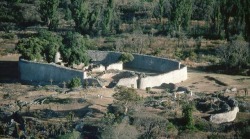Zimbabwe: Indigenous Ethnic Groups
Ellen Lakin
Period 1
World History
5/5/09
In September 1871, German explorer, Carl Mauch came upon the awe-inspiring ruins of Great Zimbabwe, 17 miles southeast of the modern Zimbabwean town of Mosivingo. Covering more than sixty acres and incorporating 900,000 granite blocks, it was the most impressive monument in the African interior, south of the Ethiopian Highlands. It is believed that at its height, 18,000 people lived at Great Zimbabwe, although the majority lived at some distance from the large stone buildings of the city. Only 200 to 300 members of the elite classes are thought to have actually lived in within the walls of Great Zimbabwe. The native, bantu speaking people of the city gathered large granite blocks from the surrounding hills to create the massive walls.Since the rock splits naturally into slabs and portable sizes they took advantage of the readily available building resource (Metropolitan Museum of Art).
Since Zimbabwe was land-locked far southeast, it was not affected by the slave trade. Though in earnest in 1890, the european conquest of the region began. Cecil Rhodes and his British South Africa Company sent military forces into the Shona territory, which it gained control of without serious fighting. Only the Ndebele kingdom in the west created serious resistance between 1893 and 1894. The British South Africa Company soon defeated them and the kingdom disappeared. In the years that followed the citizens we dissatisfied with the British Occupations. They also did not like the loss of their land, cattle, forced labor, and abuses the followed European domination (Meldrum).
More than half the countries white citizens, primarily of English origin, arrived in Zimbabwe after World War II. The ethnic groups are 98% African, 1% mixed Asian, and less than 1% are white. Between 1971 and 1979, there was a civil war between the black-majority and the white-controlled Rohdesia. The United States and Great Britain tried to negotiate and peaceful settlement, but the white Rohdesians were unwilling to relinquish political and economic power. Finally in 1978 an agreement was reached that transfered power to the black majority (ACED).
Works Cited
Armed Conflict Events Data. "Rhodesia Zimbabwe Civil War 1971-1979." OnWar.com - Wars, Military History, International Relations. 4 May 2009 <http://www.onwar.com/aced/data/romeo/rhodesia1971.htm>. This website gave me the most useful information about the indigenous people of Zimbabwe
CIA. Gov. "Zimbabwe." CIA Government. 4 May 2009 <https://www.cia.gov/library/publications/the-world-factbook/print/zi.html>. This website gave me the most useful information about the indigenous people of Zimbabwe
Category. "Great Zimbabwe (11th–15th century) | Thematic Essay | Heilbrunn Timeline of Art History | The Metropolitan Museum of Art." The Metropolitan Museum of Art, New York: metmuseum.org. 4 May 2009 <http://www.metmuseum.org/toah/hd/zimb/hd_zimb.htm>. This website gave me the most useful information about the indigenous people of Zimbabwe
Meldrum, Andrew. Where We Have Hope: A Memoir of Zimbabwe. New York: Grove Press, 2006.
"The Africa Guide - Map of Africa." African Safaris, African Tours, Africa Holidays and Africa Travel. 4 May 2009 <http://www.africaguide.com/afmap.htm>. This website gave me the most useful information about the indigenous people of Zimbabwe
Last updated by: Ellen Lakin 5/22/09

